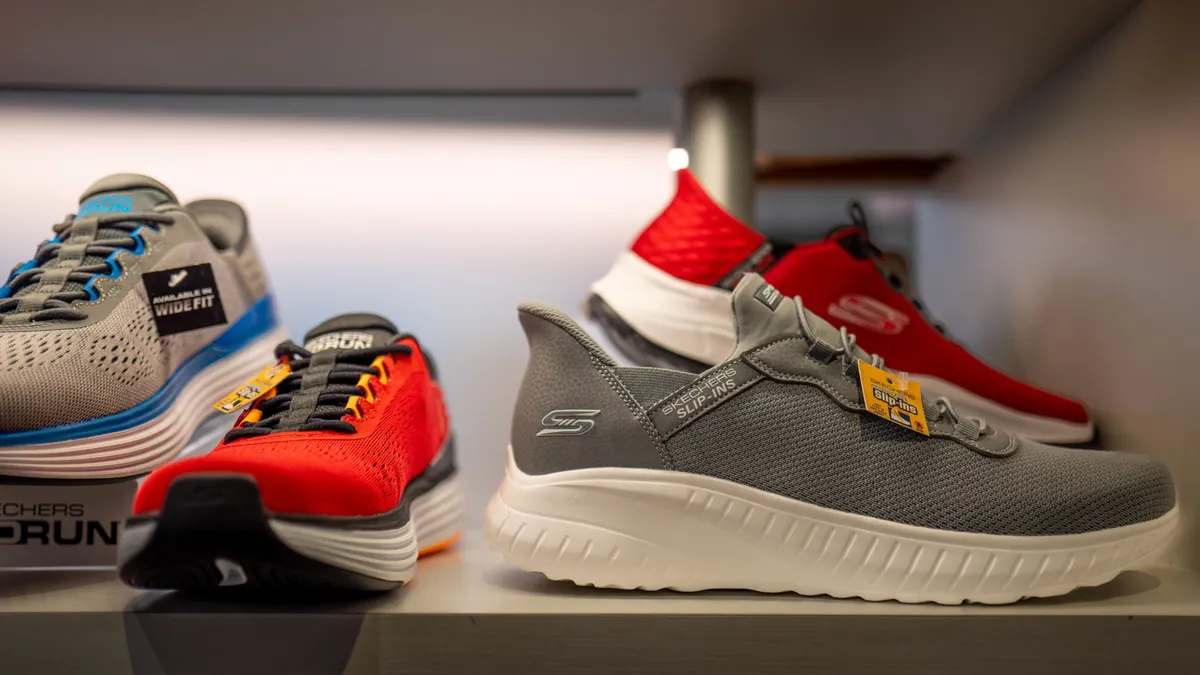Dive Brief:
- Skechers U.S.A. reported record sales of $2.41 billion in the first quarter of 2025, representing a year-over-year increase of 7%, according to a Thursday earnings report.
- Wholesale sales rose 8% to $110.5 million and wholesale volume rose 9%, while the average wholesale price declined 1%. DTC sales grew 6% to $49.5 million, with channel volume up 6%. DTC’s average selling price dropped 0.3%.
- The company pulled its previously released annual 2025 guidance and said that “due to macroeconomic uncertainty stemming from global trade policies,” it would not provide financial guidance at this time.
Dive Insight:
Despite overall positive earnings, Evercore analysts led by Jesalyn Wong said in an emailed note that the company pulling its guidance was likely to set a precedent for the Q1 earnings season.
“While understandably challenging to provide clarity on the [profit and loss] impact given how uncertain tariffs policy has been, we had hoped that [Skechers] would provide more details on the flow of the products shipments,” Wong said.
Wong added that knowing the number of Skechers products shipped from China to the U.S. would be particularly helpful for understanding how different scenarios and sensitivities could play out. “The lack of clarity is likely to keep investors on the sidelines in the near term,” Wong said.
The company’s sales in the Asia-Pacific region were down 3% in the first quarter, including a 16% decline in China. That regional downturn was offset by a 14% sales uptick in the region comprising Europe, the Middle East and Africa and an 8% sales increase in the Americas.
David Weinberg, chief operating officer of Skechers, said in the release that the company believes it has significant growth opportunities in China, and Skechers plans to continue its investments in product, marketing and infrastructure there.
Meanwhile, CFO John Vandemore said Skechers was confident in its ability to navigate the current market challenges.
“[We] know that our proven track record of managing this globally diverse brand with a unique and compelling product portfolio focused on delivering style, comfort, quality and innovation at a reasonable price will enable Skechers to endure and likely thrive during this time,” Vandemore added.
However, supply chain challenges could have an impact on the company’s bottom line, depending on how the current tariff situation plays out, said Wong.
“Any announcement to ease China tariffs will be a major catalyst” for Skechers, mainly because between 40% to 45% of its softlines are manufactured in China, Wong said.
Wong added that the majority of Skechers’ kids’ footwear products are made in China, and Evercore channel checks suggest that shipments from China to the U.S. have been halted.
“Should current tariffs situation/rates persist, Vietnam is unlikely to be able to replace the lost volumes on this segment,” Wong said. “We also understand that there is a slight premium in pricing for products made in Vietnam vs made in China.” Wong said that while shipping costs are relatively similar from both countries, shifting production toward Vietnam “in a meaningful way” could potentially impact Skechers’ margins moving forward.












